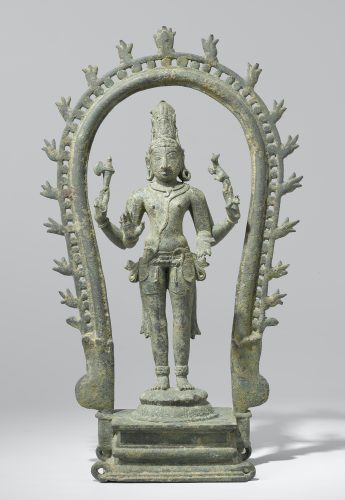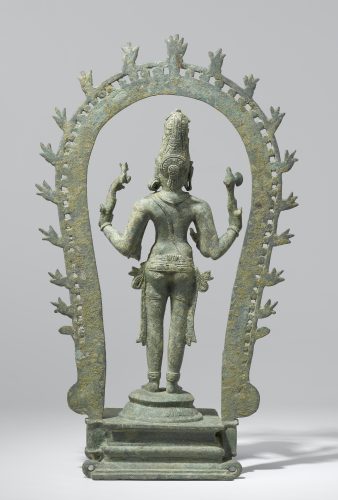
Friday May 14 2021
Aziatische Kunst Author Interview 2021/2
In cooperation with an international group of researchers, Dr. Anna Ślączka, curator of South Asian Art at the Rijksmuseum, and Sara Creange, metals conservator at the Rijksmuseum, recently investigated an image of Chandraśekhara, an important yet less-studied image of Śiva in the KVVAK’s collections. Initial results of this research will be published in the June issue of Aziatische Kunst. In this interview, dr. Ślączka tells us about Śiva myths in South India, as well as an exceptional finding inside the Chandraśekhara’s tiger-claw pendant.
1. In your article written together with Sara Creange for the June 2021 issue of Aziatische Kunst, you elaborate on an important, but less-studied image of Śiva from the Chola period (900-1250) in the KVVAK’s collections. In its formal characteristics, this Śiva, known as Chandraśekhara, or ‘the moon-crested one’, follows a specific South Indian textual prescription. Śiva carries a moon in his crest, and holds an axe in his right hand, and a tiny deer in his left hand. You write that the moon alludes to moon-related myths, while the axe and deer refer to the myth of the Pine Forest. Śiva is almost always shown with a moon, but this combination with the Pine Forest myth is specific to Tamil images of Śiva. Could you tell us about one such moon-related myth and the Pine Forest myth? And why do you think this specific combination was so popular in the South? What might the combination of two myths symbolize?
Indeed, the crescent moon on Śiva’s head is much more than just an adornment. It is associated with many mythological stories. One of the most popular myths tells about the twenty-seven daughters of Daksha (who, in fact, are the 27 constellations) given in marriage to Chandra, the moon god, under the condition that he will treat all of them equally. Chandra failed to keep the promise for he fell in love with and subsequently favorised Krittika and Rohini, the two most beautiful wives, neglecting the others. On hearing that, Daksha cursed him saying that from now on, each day he will lose one of his sixteen digits and will finally disappear altogether. When the sixteenth day arrived, Chandra, reduced to one-sixteenth of his volume and terrified, approached Śiva asking for help. Śiva placed the final digit of Chandra in his hair and assured him that he will gradually regain his lost parts, but then will lose them again, one by one, and the sequence of waning and waxing will go on as long as the universe lasts. But the crescent may also symbolize a bull’s horn and be a survival of the ancient bull cult seen in the iconography of Śiva. Or it may allude to Śiva being associated with fertility and healing (the same as the moon).
The Pine Forest myth tells us about Śiva being upset with a group of ascetics, residing in a forest of pine trees, who perform various rites and austerities but do not worship him. In order to teach them a lesson, Śiva takes the form of a handsome mendicant and, accompanied by Vishnu disguised as a beautiful woman, enters the forest. While Vishnu attempts to seduce the ascetics, Śiva encounters their wives who, because of his divine power, are immediately attracted to him. Seeing this, the ascetics grow angry. Unaware of the true identity of the intruder, they kindle a fire, chant mantras, and produce a series of magical weapons and animals from the flames, among them an axe and a deer, which they throw towards Śiva. Śiva, however, catches them one by one and overpowers them. At the end, he stands on the back of another malicious creature, the dwarf, and performs his famous dance.
The Pine Forest myth is a southern ‘remake’ of an old pan-Indian myth. The axe and the deer are therefore typically South Indian attributes of Śiva – they are held by other, typically South Indian manifestations of Śiva, such as the Somaskanda, but do not occur in the North – and, presumably, stress the importance of this myth in the South. On the other hand, it is also possible that the myth is only a nice way to explain the peculiar South Indian/Tamil iconography of the God, whose origins we may never know. It is a little like the question what was first: the hen or the egg…
Finally, the combination of the axe/deer and the moon: as all images of Śiva carry the moon, this combination is nothing special but rather something to be expected.
2. The article includes a fascinating report of the technical study of the Śiva image using neutron tomography. The Chandraśekhara image was subjected to this analysis a few years after the technical study of the famous Natarāja image, also in the KVVAK’s collections. The article describes the Chandraśekhara image as not necessarily finely modeled, yet of a high-quality bronze, with an individualistic face and elaborate ornaments. Particularly the tiger-claw pendant with metal inlay is exceptional. You write that the image may have been the product of a local workshop. What might this special pendant and its use of precious metal inlay tell us about the community that sponsored the image?
The discovery of a different material inside the pendant is already fascinating news. Such a discovery is one of a kind and, to my knowledge, there are no earlier occurrences of ornaments of Chola-period bronzes being made of another material. But to properly answer this question we must first be absolutely sure what material the pendant is made of. If it is mercury, then we could dare the hypothesis that the image was commissioned by, or for, someone practicing (or following) ayurvedic healing or alchemy. Which would make it an even more fascinating discovery. But to ascertain this, more research is necessary. Therefore, we hope to be able to do additional checks by means of gamma spectroscopy at PEARL, Reactor Institute, TU Delft, which should clear any doubts.

The KVVAK would like to thank dr. Ślączka for her participation in this interview.
